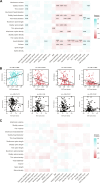Dendritic spine head diameter predicts episodic memory performance in older adults
- PMID: 39110801
- PMCID: PMC11305389
- DOI: 10.1126/sciadv.adn5181
Dendritic spine head diameter predicts episodic memory performance in older adults
Abstract
Episodic memory in older adults is varied and perceived to rely on numbers of synapses or dendritic spines. We analyzed 2157 neurons among 128 older individuals from the Religious Orders Study and Rush Memory and Aging Project. Analysis of 55,521 individual dendritic spines by least absolute shrinkage and selection operator regression and nested model cross-validation revealed that the dendritic spine head diameter in the temporal cortex, but not the premotor cortex, improved the prediction of episodic memory performance in models containing β amyloid plaque scores, neurofibrillary tangle pathology, and sex. These findings support the emerging hypothesis that, in the temporal cortex, synapse strength is more critical than quantity for memory in old age.
Figures



Similar articles
-
Disrupted Maturation of Prefrontal Layer 5 Neuronal Circuits in an Alzheimer's Mouse Model of Amyloid Deposition.Neurosci Bull. 2023 Jun;39(6):881-892. doi: 10.1007/s12264-022-00951-5. Epub 2022 Sep 24. Neurosci Bull. 2023. PMID: 36152121 Free PMC article.
-
Short-Term Memory Impairment.2024 Jun 8. In: StatPearls [Internet]. Treasure Island (FL): StatPearls Publishing; 2025 Jan–. 2024 Jun 8. In: StatPearls [Internet]. Treasure Island (FL): StatPearls Publishing; 2025 Jan–. PMID: 31424720 Free Books & Documents.
-
Association of Sleep-Disordered Breathing and Medial Temporal Lobe Atrophy in Cognitively Unimpaired Amyloid-Positive Older Adults.Neurology. 2023 Jul 25;101(4):e370-e385. doi: 10.1212/WNL.0000000000207421. Epub 2023 May 31. Neurology. 2023. PMID: 37258299 Free PMC article.
-
Botulinum toxins for the prevention of migraine in adults.Cochrane Database Syst Rev. 2018 Jun 25;6(6):CD011616. doi: 10.1002/14651858.CD011616.pub2. Cochrane Database Syst Rev. 2018. PMID: 29939406 Free PMC article.
-
Falls prevention interventions for community-dwelling older adults: systematic review and meta-analysis of benefits, harms, and patient values and preferences.Syst Rev. 2024 Nov 26;13(1):289. doi: 10.1186/s13643-024-02681-3. Syst Rev. 2024. PMID: 39593159 Free PMC article.
Cited by
-
Neurodegenerative processes of aging: A perspective of restoration through insulin-like growth factor-1.Neural Regen Res. 2026 Apr 1;21(4):1562-1563. doi: 10.4103/NRR.NRR-D-24-01595. Epub 2025 Feb 24. Neural Regen Res. 2026. PMID: 39995074 Free PMC article. No abstract available.
References
Publication types
MeSH terms
Grants and funding
- P30 AG072975/AG/NIA NIH HHS/United States
- R01 AG061800/AG/NIA NIH HHS/United States
- U01 AG061356/AG/NIA NIH HHS/United States
- R01 AG017917/AG/NIA NIH HHS/United States
- R21 AG085379/AG/NIA NIH HHS/United States
- T32 NS061788/NS/NINDS NIH HHS/United States
- P30 AG010161/AG/NIA NIH HHS/United States
- RF1 AG063755/AG/NIA NIH HHS/United States
- P20 AG068024/AG/NIA NIH HHS/United States
- F99 AG083305/AG/NIA NIH HHS/United States
- R01 AG015819/AG/NIA NIH HHS/United States
- R01 AG061798/AG/NIA NIH HHS/United States
- U01 AG046152/AG/NIA NIH HHS/United States
- R01 AG054719/AG/NIA NIH HHS/United States
- F31 AG067635/AG/NIA NIH HHS/United States
LinkOut - more resources
Full Text Sources

